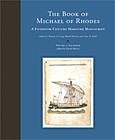- About MAA
- Membership
- MAA Publications
- Periodicals
- Blogs
- MAA Book Series
- MAA Press (an imprint of the AMS)
- MAA Notes
- MAA Reviews
- Mathematical Communication
- Information for Libraries
- Author Resources
- Advertise with MAA
- Meetings
- Competitions
- Programs
- Communities
- MAA Sections
- SIGMAA
- MAA Connect
- Students
- MAA Awards
- Awards Booklets
- Writing Awards
- Teaching Awards
- Service Awards
- Research Awards
- Lecture Awards
- Putnam Competition Individual and Team Winners
- D. E. Shaw Group AMC 8 Awards & Certificates
- Maryam Mirzakhani AMC 10 A Awards & Certificates
- Two Sigma AMC 10 B Awards & Certificates
- Jane Street AMC 12 A Awards & Certificates
- Akamai AMC 12 B Awards & Certificates
- High School Teachers
- News
You are here
The Book of Michael of Rhodes: A Fifteenth-Century Maritime Manuscript, Volume 1: Facsimile

Publisher:
MIT Press
Publication Date:
2009
Number of Pages:
519
Format:
Hardcover
Price:
65.00
ISBN:
9780262135030
Category:
Monograph
[Reviewed by , on ]
Fernando Q. Gouvêa
04/22/2010
This three-volume set is a spectacular demonstration of what can be done with modern technology and generous funding. It offers us all a chance to experience what it would be like to read a 15th century manuscript, while also giving us access to the insights of scholars.
Beginning in 1401, Michael of Rhodes spent some four decades working in the Venetian military and commercial fleets, and along the way he learned a lot of practical mathematics. Around 1434, he began to record this material. The book that resulted survives as a manuscript with 241 sheets, which include 180 pages of commercial mathematics, some astrology, various tables, and other documents.
The manuscript was unknown to scholars until 1966, when a private collector put it up for sale. Alas, it was sold to another private collector, who did not allow access to the manuscript. Finally, in 2000, the manuscript was sold again, this time to a private collector willing to share with scholars. Working with the Dibner Institute, he created the Michael of Rhodes Project and obtained funding from NEH and other foundations. The results include a web site, now hosted by the Institute and Museum of the History of Science, and this three-volume Book of Michael of Rhodes.
The first volume of the set contains a full-color reproduction of the manuscript. Every page is reproduced, including the blank ones. Also included are reproductions of six additional documents from Michael’s time: the wills of both Michael and his wife (in several versions) and a manuscript noting that Michael was responsible for the loss of some oars on one of his trips.
The second volume presents a transcription of the manuscript (which is in Italian, of course) with an English translation on facing pages. Translations of the supplemental manuscripts included in volume one are also given, and — wonder of wonders — there are indices that allow one to locate specific things in the manuscript.
The third and final volume is a collection of studies by various scholars. Two of these are context-setting, and the others consider various parts of the manuscript. Raffaella Franci writes about the mathematics.
The set is beautifully made, with excellent reproductions printed on excellent paper. Given the quality, the price is remarkably low.
Some of this material can also be found online at the Michael of Rhodes Project site, including a selection of manuscript pages (with transcription and translation). For the most part, however, the material online is different from the material to be found in the books. For example, the site includes some more elementary background material that nicely complements the more technical analysis found here.
Students of the history of mathematics rarely have such direct access to primary source materials; if this set were available to them, it would open up an interesting range of possible projects. The mathematics that appears here is fairly elementary, allowing them to concentrate on the history, i.e., on how this mathematics is different from ours and how it reflects its cultural context. I think this set would make a valuable addition to a mathematics library.
Fernando Q. Gouvêa is Carter Professor of Mathematics at Colby College and the author, with William P. Berlinghoff, of Math through the Ages. He loves old books.
The table of contents is not available.
- Log in to post comments




